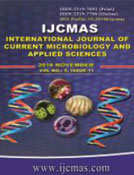


 National Academy of Agricultural Sciences (NAAS)
National Academy of Agricultural Sciences (NAAS)

|
PRINT ISSN : 2319-7692
Online ISSN : 2319-7706 Issues : 12 per year Publisher : Excellent Publishers Email : editorijcmas@gmail.com / submit@ijcmas.com Editor-in-chief: Dr.M.Prakash Index Copernicus ICV 2018: 95.39 NAAS RATING 2020: 5.38 |
The goal of study was to investigate the effect of certain species of Aspergillus and Trichoderma hamatum and their combination on growth and yield of wheat- Ibaa 99. The Study conducted in Wasit province during 2014-2015 and 2015-2016 agricultural seasons and the impact of fungi were evaluated according to the following treatments: Aspergillus niger (A.n.), Aspergillus fumigatus (A.f.) and Trichoderma hamatum (T.h.) and combination of both (A. n. + T. h.) and (A. f. + T. h.) and (A. n. + A. f. + T. h.). The wheat (var.Ibaa99) seeded in blocks with five replicates per treatment, the fungi loaded on peatmoss before applied as inoculum at a rate of 2 liters per block. The experimental data considered of average plants height (cm), dry weight (gm), spike length (cm), spike’s weight (gm) and grain weight (gm) for ten plants per square meter. The results showed that examined fungi and their combination have significant effects on growth and yield of wheat in all treatment compared with the control in two agriculture seasons, The best treatments was combination of (A. n. + T. h.) and (A. n.), which gave the highest amount of grain yield was 674.25 and 638.82 gm/m2, respectively, compared with control treatment 475.65 gm/ m 2. The results also showed that the highest effective fungi in this study (A. n. + T. h.) and (A. n.) have positive effect on wheat characteristics in addition to growth and yield in both seasons, such as increasing emergence ratio by No. of plant per m2 that gave 232.5 and 236.6 plantm2 respectively compare with control treatment that gave 226.5 plantm2 and average spike’s weight (gm) that gave 2.9 and 2.7 gm and 2.1 gm in control. In the agriculture season 2015-2016, the results showed significant effect for teat (A.n.+ T.h) in all growth attributes and yields of wheat compare with control treatment. The antifingal activity indicated that fungal isolates have inhibitory efficiency towards the two pathogens fungi Fusarium oxysporum and Rhizoctonia solani. And the Antifungal activity of (A.n.) was highest 66.71% against pathogens fungi Fusarium oxysporum while (T.h.) was the highest 77.77% against pathogens fungi Rhizoctonia solani. The Physiological and chemical characteristics of wheat grain shown that (A.n.+ T.h) contained the highest percentage of glutin 25.13% and ash 2.04%, also it was highest in G.W. 80.97 kghl and W.T.K. 30.53 gm in addition to increasing falling number Fa.No.in 629 sec. indicating highest in enzymic activated among the tested sample of treatment. While the treat (A.n.) had highest percentage of protein 13.8% followed by (A.n.+ A.f.+T.h) 13.73% and (T.h.) 13.3 % where (A.f.) had the lowest value 12.9%. These results records possibilities of these effective fungi can depend on promoting growth and yield of wheat to make it as bio-fertilizer.
 |
 |
 |
 |
 |